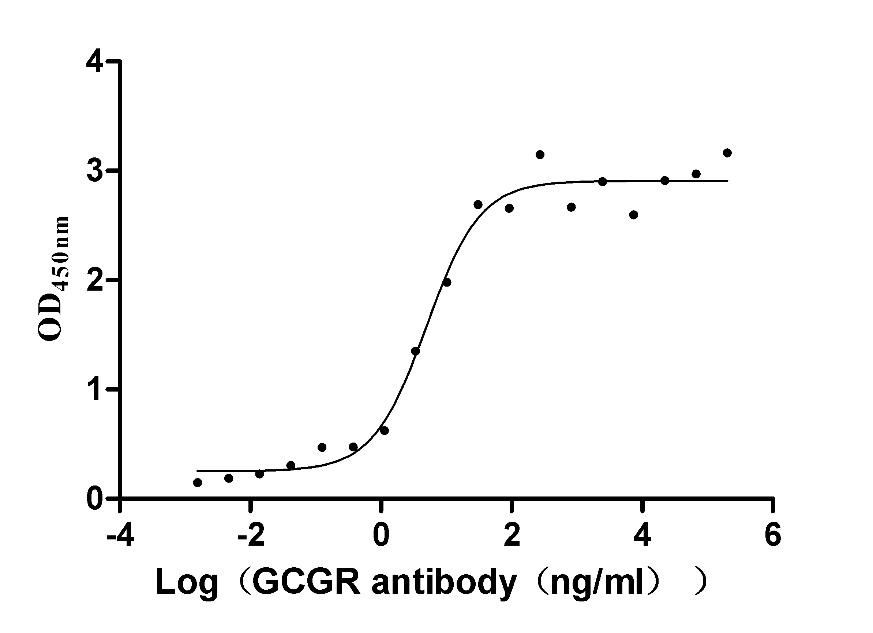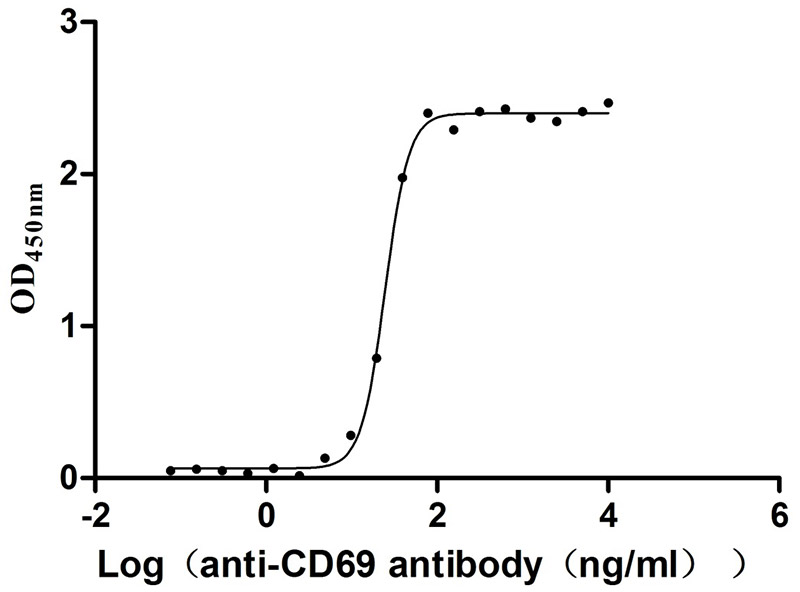Recombinant Mouse Transferrin receptor protein 1 (Tfrc), partial
-
货号:CSB-YP726792MO
-
规格:
-
来源:Yeast
-
其他:
-
货号:CSB-EP726792MO-B
-
规格:
-
来源:E.coli
-
共轭:Avi-tag Biotinylated
E. coli biotin ligase (BirA) is highly specific in covalently attaching biotin to the 15 amino acid AviTag peptide. This recombinant protein was biotinylated in vivo by AviTag-BirA technology, which method is BriA catalyzes amide linkage between the biotin and the specific lysine of the AviTag.
-
其他:
-
货号:CSB-BP726792MO
-
规格:
-
来源:Baculovirus
-
其他:
-
货号:CSB-MP726792MO
-
规格:
-
来源:Mammalian cell
-
其他:
产品详情
-
纯度:>85% (SDS-PAGE)
-
基因名:
-
Uniprot No.:
-
别名:Tfrc; Trfr; Transferrin receptor protein 1; TR; TfR; TfR1; Trfr; CD antigen CD71
-
种属:Mus musculus (Mouse)
-
蛋白长度:Partial
-
蛋白标签:Tag type will be determined during the manufacturing process.
The tag type will be determined during production process. If you have specified tag type, please tell us and we will develop the specified tag preferentially. -
产品提供形式:Lyophilized powder
Note: We will preferentially ship the format that we have in stock, however, if you have any special requirement for the format, please remark your requirement when placing the order, we will prepare according to your demand. -
复溶:We recommend that this vial be briefly centrifuged prior to opening to bring the contents to the bottom. Please reconstitute protein in deionized sterile water to a concentration of 0.1-1.0 mg/mL.We recommend to add 5-50% of glycerol (final concentration) and aliquot for long-term storage at -20℃/-80℃. Our default final concentration of glycerol is 50%. Customers could use it as reference.
-
储存条件:Store at -20°C/-80°C upon receipt, aliquoting is necessary for mutiple use. Avoid repeated freeze-thaw cycles.
-
保质期:The shelf life is related to many factors, storage state, buffer ingredients, storage temperature and the stability of the protein itself.
Generally, the shelf life of liquid form is 6 months at -20°C/-80°C. The shelf life of lyophilized form is 12 months at -20°C/-80°C. -
货期:Delivery time may differ from different purchasing way or location, please kindly consult your local distributors for specific delivery time.Note: All of our proteins are default shipped with normal blue ice packs, if you request to ship with dry ice, please communicate with us in advance and extra fees will be charged.
-
注意事项:Repeated freezing and thawing is not recommended. Store working aliquots at 4°C for up to one week.
-
Datasheet :Please contact us to get it.
相关产品
靶点详情
-
功能:Cellular uptake of iron occurs via receptor-mediated endocytosis of ligand-occupied transferrin receptor into specialized endosomes. Endosomal acidification leads to iron release. The apotransferrin-receptor complex is then recycled to the cell surface with a return to neutral pH and the concomitant loss of affinity of apotransferrin for its receptor. Transferrin receptor is necessary for development of erythrocytes and the nervous system. Upon stimulation, positively regulates T and B cell proliferation through iron uptake. Acts as a lipid sensor that regulates mitochondrial fusion by regulating activation of the JNK pathway. When dietary levels of stearate (C18:0) are low, promotes activation of the JNK pathway, resulting in HUWE1-mediated ubiquitination and subsequent degradation of the mitofusin MFN2 and inhibition of mitochondrial fusion. When dietary levels of stearate (C18:0) are high, TFRC stearoylation inhibits activation of the JNK pathway and thus degradation of the mitofusin MFN2.
-
基因功能参考文献:
- duodenal Regnase-1 controls the expression of PHD3, which impairs duodenal iron uptake via HIF2alpha suppression. PMID: 28538180
- role in the development of hypoxia-induced pulmonary vascular remodeling PMID: 26419445
- Knock-out of TFR1 in Purkinje cells reduces mGlu1 expression at synapses and impairs motor coordination. PMID: 29054881
- decreasing TfR1 expression during beta-thalassemic erythropoiesis, either directly via induced haploinsufficiency or via exogenous apotransferrin, decreases ineffective erythropoiesis and provides an endogenous mechanism to upregulate hepcidin, leading to sustained iron-restricted erythropoiesis and preventing systemic iron overload in beta-thalassemic mice PMID: 28151426
- our study reveals that TFR functions as a novel regulator to control AMPA trafficking efficiency and synaptic plasticity PMID: 26880306
- We found that iron assimilation via Tfr1 was critical for skeletal muscle metabolism, and that iron deficiency in muscle led to dramatic changes, not only in muscle, but also in adipose tissue and liver. PMID: 26870796
- Mice lacking Tfr1 in the heart died in the second week of life and had cardiomegaly, poor cardiac function, failure of mitochondrial respiration, and ineffective mitophagy. PMID: 26456827
- Transferrin Receptor 1 Facilitates Poliovirus Permeation of Mouse Brain Capillary Endothelial Cells. PMID: 26637351
- Erythrocytic iron deficiency enhances susceptibility to Plasmodium chabaudi infection in mice carrying a missense mutation in tfr1. PMID: 26303393
- Tfr1 has a role in homeostatic maintenance of the intestinal epithelium, acting through a role that is independent of its iron-uptake function PMID: 26324903
- Analysis by qPCR showed changes in mRNA levels of iron-responsive genes, indicating moderately increased iron in the RPE of 10-month HID mice. PMID: 26275132
- characterization of erythropoiesis, iron status, and hepcidin expression in mice with global or hematopoietic cell-specific haploinsufficiency of transferrin receptor 1 provides initial supporting data for this model PMID: 25782630
- high levels of TfRs such as those found on activated lymphocytes were found to be associated with decreased KLRG1 inhibitory function, indicating that TfRs may sequester KLRG1 from interacting with cadherins. PMID: 24752778
- data further demonstrate that the inhibitory activity of KLRG1 is decreased in T cells expressing high levels of TfR, indicating that association of KLRG1 with TfR hinders KLRG1-mediated silencing. PMID: 24515870
- high-affinity anti-TfR alters TfR trafficking, which dramatically impacts the capacity for TfR to mediate blood-brain barrier transcytosis PMID: 24470444
- Data indicate increased levels of reactive oxygen species (ROS) were detected in bone marrow nucleated cells (BMNC) that express CD71 in in NUP98-HOXD13 (NHD13) transgenic mice, a murine model for myelodysplastic syndromes (MDS). PMID: 23958061
- Knockdown of Rab12 increased transferrin receptor level and reduced M98K-induced cell death. PMID: 23357852
- results suggest that TfR1 would be highly expressed by neurons rather than astroglia to play a negative role in the neurite outgrowth after the incorporation of circulating transferrin in the brain PMID: 22019713
- In a model of celiac disease, gluten induces enterocyte CD71 overexpression. PMID: 22330344
- TfR is constitutively degraded by a Rab12-dependent pathway (presumably from recycling endosomes to lysosomes), which is independent of the conventional degradation pathway. PMID: 21718402
- 5-aza-2'-deoxycytidine activates iron uptake and heme biosynthesis by increasing c-Myc nuclear localization and binding to the E-boxes of transferrin receptor 1 (TfR1) and ferrochelatase (Fech) genes. PMID: 21903580
- Vitamin C increases the expression of the iron-regulated hormone hepcidin and decreases transferrin receptor 1 (TfR1) expression in liver. PMID: 21078691
- TfR1 in colon cancer-bearing mice exhibited a 24-hour rhythm in mRNA and protein levels. Experiments suggest that the clock-controlled gene c-MYC rhythmically activated the transcription of the TfR1 gene. PMID: 20631077
- used phenotypic screening of the T31 mouse/hamster radiation hybrid panel to map the MMTV cell entry receptor gene and subsequently found that it is transferrin receptor 1 PMID: 12218182
- soluble transferrin receptor represents a valuable quantitative assay of marrow erythropoietic activity as well as a marker of tissue iron deficiency PMID: 12589962
- both adult erythropoiesis and lymphopoiesis require TfR; TfR is necessary for the normal maturation of thymocytes, but that B-cell development is less severely affected by the absence of TfR PMID: 12881306
- Direct binding of mouse mammary tumor virus to TLR4 up regulated expression of the MMTV entry receptor (CD71) on bone marrow derived dendritic cells PMID: 14694089
- hepcidin transgene expression decreases transferrin receptor 1 mRNA level in placenta PMID: 15358563
- Dcytb, DMT1, Ireg1 and transferrin receptor 1 have roles in iron transport and hemolysis PMID: 15469906
- TfR1 expression is attenuated in a cell-density-dependent manner in human lung cancer H1299 cells and in murine B6 fibroblasts as the result of a marked decrease in mRNA content. PMID: 16092918
- the site of interaction with MMTV maps to two segments physically disparate from the TfR and HFE binding sites PMID: 16481319
- HFE and TFR2 interact in cells; this interaction is not abrogated by disease-associated mutations of HFE and TFR2; and that TFR2 competes with TFR1 for binding to HFE PMID: 16893896
- These data indicate that rapid transferrin recycling is defective after pSec15l1 has mutated. PMID: 17087999
- Although expression of high levels of sTfR1 significantly increased serum iron levels, repeated experiments showed that neither hsTfR1 nor msTfR1 gene expression had any effect on iron absorption or hepcidin mRNA expression levels. PMID: 17119325
- Mammalian cells utilize transferrin-dependent mechanisms to acquire iron via transferrin receptors 1 and 2 (TfR1 and TfR2) by receptor-mediated endocytosis. PMID: 17121833
- The modified vectors containing Q-dots demonstrated 32-fold greater tumor-targeting efficiency than wild-type HVJ-E. PMID: 17961511
- comparison of the abilities of TfR1 orthologs from different species to support arenavirus entry found that the human and feline receptors were able to enhance entry of the pathogenic strains, but that neither the murine or canine forms were functional. PMID: 18003730
- Iron chelation alters expression of Tfrc. PMID: 18029550
- Suggest that Hfe induces hepcidin expression when it is not in complex with Tfr1. PMID: 18316026
- an interplay of the HIF-1 and NF-kappaB pathways controls TfR1 transcription in inflammation PMID: 18519569
- increased mitochondrial Fe in the myocardium of mutants was due to marked transferrin Fe uptake, which was the result of enhanced transferrin receptor 1 expression PMID: 18621680
- Transferrin receptor can be used as a specific target for molecular imaging in CIA mouse, and 99mTc-Tf scintigraphy detects synovial inflammation prior to significant clinical findings in collagen-induced arthritis mouse. PMID: 18696076
- Mouse mammary tumor virus uses TfR1 for all steps of entry: cell attachment, induction of the conformational changes in Env required for membrane fusion and internalization to an appropriate acidic compartment PMID: 18829060
- Results indicate that TfR promotes glioma progression by two mechanisms, an increase in proliferation rate and glutamate production, the latter mechanism providing space for the progressing tumor mass. PMID: 19066835
显示更多
收起更多
-
亚细胞定位:Cell membrane; Single-pass type II membrane protein. Melanosome.
-
蛋白家族:Peptidase M28 family, M28B subfamily
-
数据库链接:
KEGG: mmu:22042
STRING: 10090.ENSMUSP00000023486
UniGene: Mm.28683
Most popular with customers
-
Recombinant Human Glucagon receptor (GCGR), partial (Active)
Express system: Mammalian cell
Species: Homo sapiens (Human)
-
Recombinant Human Nectin-4 (NECTIN4), partial (Active)
Express system: Mammalian cell
Species: Homo sapiens (Human)
-
Recombinant Human R-spondin-1 (RSPO1), partial (Active)
Express system: Mammalian cell
Species: Homo sapiens (Human)
-
Recombinant Human Cannabinoid receptor 1 (CNR1)-VLPs (Active)
Express system: Mammalian cell
Species: Homo sapiens (Human)
-
Recombinant Human Claudin-3 (CLDN3)-VLPs (Active)
Express system: Mammalian cell
Species: Homo sapiens (Human)
-
Recombinant Human Alkaline phosphatase, germ cell type (ALPG) (Active)
Express system: Mammalian cell
Species: Homo sapiens (Human)
-
Recombinant Human Early activation antigen CD69 (CD69), partial (Active)
Express system: Mammalian cell
Species: Homo sapiens (Human)
-
Recombinant Human Cell adhesion molecule 1 (CADM1), partial (Active)
Express system: Mammalian cell
Species: Homo sapiens (Human)




















